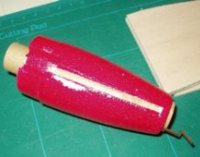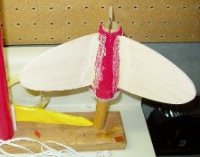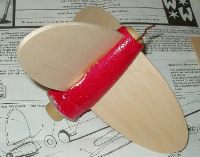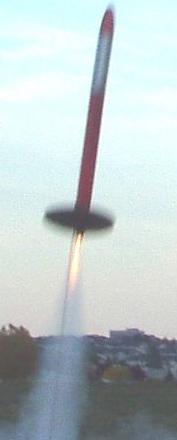| Manufacturer: | Fun Rockets |
 Intro
Intro
A modification of a cheap bad rocket into a cheap good rocket.
I couldn't resist it. There it was sitting on the shelf at Hobby Lobby, with a clearance price tag. I thought long and hard. This rocket had a bad reputation, Styrofoam. It had replaced all of the balsa wood in the original kit. The reviews were bad and the owner was trying to unload the remaining inventory because it was a dog. I thought some more and then placed my $1.25 on the counter and walked out with a genuine Edsel of the model rocket world, a Fun Rockets Wicked Winnie.
After I got it home and summoned the courage to open the box and take a look at the kit, there it was, Styrofoam boat tail, Styrofoam fins, Styrofoam bulkhead and Styrofoam nose cone. It wasn't pretty. It sat on my workbench for a couple of weeks while I thought on how best to use the rocket, should I part it out, should I build it stock, what should I do?
I finally decided to build it as stock as possible. I only paid a buck and a quarter for the kit, it was practically a disposable rocket at that price. The first attempt at installing the fins was a disaster. They don't fit. I thought about sanding them but the Styrofoam looked like it could handle one launch and then crack on landing. At this point I deviated from my original thought and decided to modify the rocket to make it useable. The goal at this point was to make the minimum modifications to the rocket, but also to have a fully functional rocket.
With this thought in mind, I finally decided upon replacing the fin with balsa fins. I realized that the motor mount in the boat tail was a rather nice stout cardboard tube. If I could only slot the boat tail where the fins are, then the fins could glue to the motor mount instead of the Styrofoam. This was easier than I thought. The Styrofoam cuts easily with a sharp X-Acto knife leaving a through the boat tail mounting for the fins. I then used the Styrofoam fins as a template for 1/4" balsa replacements, keeping in mind that they would have to be larger at the root edge to actually go through to the motor mount. After the fins were cut and sanded roughly alike I mounted them to the motor mount and the surrounding Styrofoam with a generous amount of glue. Once this was done and the fins were dry, I added fillets and sealed the fins using Elmer's Fill-n-Finish.



Then the next problem reared it's ugly head. I decided to paint the fin unit before installing it in the rest of the rocket since the balsa fins are the only thing on this rocket that are not painted. I pulled out the trusty Krylon primer, and started to cover the fins and boat tail in gray paint. But wait, what was that sound that I was hearing. Faint cries of "I'm Melllltiiiing!" echoed throughout the yard. I looked at the once smooth surface of the boat tail slowly shriveling away. What to do now? Was all that work in vain? It was time to fall back and regroup. Obviously the Styrofoam did not like the solvents in the Krylon primer, I should have tested it on a spare fin, but in my haste I skipped the compatibility test. There was only one thing left to do, coat the entire boat tail with Fill-n-Finish so that none of the Styrofoam would see the primer and paint again. After several coats of the fill-n-finish, I approached the primer with fear and trepidation. Fortunately the coating held and the fin section was finished with a semi-gloss black paint.
The rest of the construction was uneventful. Install a paper ring on the tail section, and then glue the tail section into the body tube. Done. The rocket was now complete and ready to fly, the parachute is pre-assembled and the rest of the rocket was already painted. I added the Wicked Winnie sticker to the side and she was ready to fly
Flying the Winnie
 Finally I found a gap in the hectic pace of
the summer that also had a lack of wind, and took my recovery crew out to the
local football field to launch Winnie and a couple of the other birds that I
had managed to slap together this summer.
Finally I found a gap in the hectic pace of
the summer that also had a lack of wind, and took my recovery crew out to the
local football field to launch Winnie and a couple of the other birds that I
had managed to slap together this summer.
First flight was on a B6-4. It was a fairly slow liftoff, and the parachute ejected just after apogee. The parachute gave a good rate of descent and the nose cone popped off and floated down separately. Note to self: tape the nose cone on, and put on a bigger parachute if there is a payload in the rocket.
The second flight was on a C6-5. This was an easy choice at this point since the other rockets had all broken fins off at landing. The flight was great, nice and high with the ejection at apogee. Again the nose cone popped off and floated back separately. Note to self again: Tape the outside of the nose cone, not the shoulder on the inside since the Styrofoam compresses, thus rendering the extra tape useless.
Overall Impressions
The stock out-of-the-box Wicked Winnie is a dog. However with the addition of
the balsa fins and taping the nose cone on (I will probably tape or glue the
bulkhead in as well) this is a cheap good payload rocket. I didn't take the
time to shape the fins but that would only help the flight characteristics of
this rocket. As these are seen at clearance prices, this is a really cheap way
to get a larger low power payload rocket.
Other Reviews
- Fun Rockets Wicked Winnie By Bill Eichelberger (June 16, 2015)
Back in the good ol' days when Hobby Lobby could be counted on to stock a variety of kits from companies other than the Big E, I picked the Fun Rockets Wicked Winnie up on clearance for a song. I'd already owned a Tangent and Zoomie, so when I saw this one on the block it was just natural to pick it up for use at B6-4 Field. Components Main body tube with cheesy foam ...
- Fun Rockets Wicked Winnie By David Logan
( Contributed - by David Logan) Brief: This is the re-design of the Holverson Wicked Winnie payload kit, using styrofoam nose cone, boat tail, and fins. Construction: The body tubes included are thick paper tubes, one for the main airframe, and one for the payload section. The boat tail, nose cone, fins, and coupler are all made of expanded styrofoam. This kit is mostly ...
 |
 |
Flights
Sponsored Ads
 |
 |











